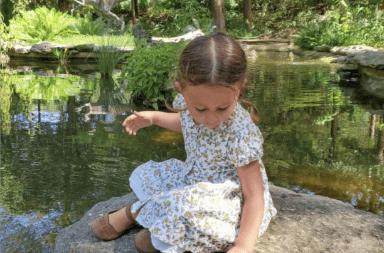 When Central Texas weather takes a deep dip into icy cold temps, it’s a good time snuggle up with science fun in your own backyard! Our friends at the Science Mill museum in Johnson City have some terrific ideas to explore with the young scientists in your house. When Austin meets the Arctic, try some of these activities that add some smiles and wonder to the winter weather.
When Central Texas weather takes a deep dip into icy cold temps, it’s a good time snuggle up with science fun in your own backyard! Our friends at the Science Mill museum in Johnson City have some terrific ideas to explore with the young scientists in your house. When Austin meets the Arctic, try some of these activities that add some smiles and wonder to the winter weather.
Freeze Stuff!

An ice xylophone powered by Makey Makey alligator clips makes music at the Science Mill’s annual Snow Day
Colorful Ice: Got handy household items like balloons, Ziploc bags or vinyl gloves? Add water and a few drops of food coloring, if you have some, and close them or tie with a knot. Set them outside and see how long it takes each one to freeze. When the ice is ready, help your kids cut away the balloon or glove, or carefully remove the ice from the plastic containers.
Frozen Toys: You can also freeze water in a variety of plastic containers of all sizes and shapes—think ice trays, yogurt containers, food storage bins, etc. Experiment by adding plastic toys, coins, beans, chalk, berries, leaves or other easy-to-find items. Can you make an artistic frozen masterpiece? Excavate a dinosaur from frozen tundra? Talk about how archaeologists find discoveries that have been trapped in ice for millennia!
Slo-Mo Freeze Race: If you have table salt (sodium chloride) and Epsom salts (magnesium sulfate) at home, try dissolving them in water for a slow-motion freezing race. Create three equal cups: one with plain tap water, one with tap water + table salt and one with tap water + Epsom salts. Put them in the cold and check back often to see how long it takes each one to freeze. Do the additional chemicals change how the water freezes?
Blow Bubbles!
 If you’re up for going outside when it’s REALLY cold, below about 9 to 12 degrees Fahrenheit, try blowing bubbles! Either the pre-made bubble mix that comes with its own wand or DIY bubble solution (½ gallon of water + ½ cup dish soap; optional: add 1 Tbsp glycerin or 1 Tbsp white karo syrup) will work. Try attaching a paperclip or pipe cleaner to a straw to make a custom bubble wand. You can also add a few drops of food coloring. When you’re outside, try to make the bubbles as high up as you can, so there’s time for them to get even colder as they move through the air. You can also try placing a bubble on a plate in the freezer to see if it will freeze!
If you’re up for going outside when it’s REALLY cold, below about 9 to 12 degrees Fahrenheit, try blowing bubbles! Either the pre-made bubble mix that comes with its own wand or DIY bubble solution (½ gallon of water + ½ cup dish soap; optional: add 1 Tbsp glycerin or 1 Tbsp white karo syrup) will work. Try attaching a paperclip or pipe cleaner to a straw to make a custom bubble wand. You can also add a few drops of food coloring. When you’re outside, try to make the bubbles as high up as you can, so there’s time for them to get even colder as they move through the air. You can also try placing a bubble on a plate in the freezer to see if it will freeze!
Make a Mini Snowball Catapult!
To make a snowball (or ice cube) catapult, you’ll need several large and small craft sticks, rubber bands and a plastic spoon OR the cap from a milk jug or soda bottle. Stack two large craft sticks and use a rubber band to hold them together on one end. Next, stack 5-7 smaller craft sticks and rubber band them together on both ends. Carefully separate the larger sticks and wedge the stack of smaller sticks between them. Hold everything in place by stretching two rubber bands from the back of the bundle criss-crossing to the front, making an X. Use a rubber band to attach a plastic spoon to one of the large craft sticks, or glue a plastic milk jug cap or bottle cap to the end. Put a mini snowball, cotton ball, or other object in your spoon and press down on the edge of the spoon—then release it and watch your snowball fly!
The Science Mill also offered these other ideas for cold weather days:
- Get a behind-the-scenes look at the science of some favorite museum exhibits and find DIY science activities on the Explorer Zone.
- Go inside NASA’s mission to Mars with a free downloadable board game and other space resources to celebrate the upcoming landing of the Perseverance rover.
- Explore The Future of Science with video talks by leading scientists and visionaries on such diverse topics as butterfly migration, “galactic fossils” and artificial intelligence.
We love these suggestions for cold weather fun! Learn more about the Science Mill and plan a visit! You can get all the details about current exhibits, safety protocols and museum hours on www.sciencemill.org. Check out their YouTube channel for interesting videos & virtual field trips, and follow them on Facebook, Instagram, and Twitter to keep up with their latest news and special events.




